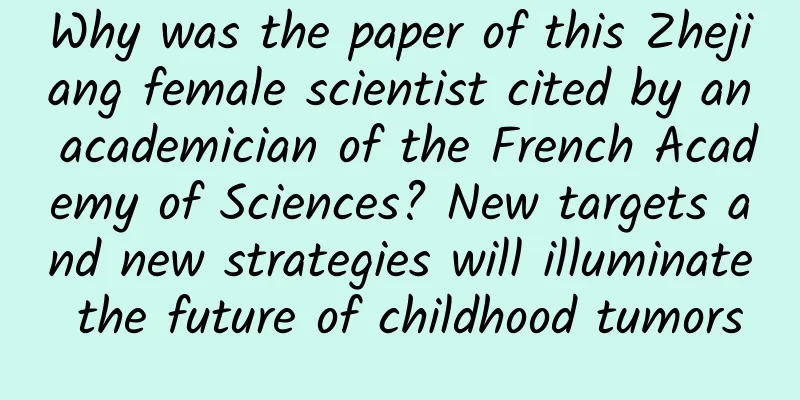Why was the paper of this Zhejiang female scientist cited by an academician of the French Academy of Sciences? New targets and new strategies will illuminate the future of childhood tumors

|
Reporter Weng Danni Photographer Jin Jingxin Publisher: Ying Meidan, professor and doctoral supervisor at the School of Pharmacy, Zhejiang University, and Young Yangtze River Scholar of the Ministry of Education Published results: Discovery of new drug targets for pediatric tumors and progress in innovative drug research The medical documentary "Human World" has an episode called "Fireworks", which focuses on a group of children with a 3 in 1,000,000 chance of suffering from the same disease - osteosarcoma. This group of children who should have enjoyed a carefree childhood, showed the scene of parents, doctors and children fighting against death together, and also let more people see the cruelty of childhood tumors. Many people don’t associate “tumors” with “children.” But in fact, about 263,000 children are diagnosed with tumors every year around the world, and malignant tumors have become the second leading cause of death among children after accidental deaths. On the other hand, compared with the rapid development of adult tumors in recent years, children's tumor drugs are still extremely scarce, and the current status of children's tumor treatment can even be summarized as "lack of doctors and drugs". Fortunately, more and more scientific research forces are beginning to join the team of children's tumor research, and Ying Meidan, a professor and doctoral supervisor at the School of Pharmacy of Zhejiang University, is one of them. This morning, the first "Popular Science Release of Scientific and Technological Achievements" of the year came to Zhejiang University Institute of Intelligent Drugs. Professor Ying Meidan told us about their team's latest research results on childhood tumors at the event. Children's tumors are not "smaller versions" of adult tumors In her opinion, there is no "failure" in scientific research Are childhood cancers the same as adult cancers? Since adult cancer drugs have been studied more, can children with cancer use adult drugs? The answer is not that simple. Professor Ying Meidan told us that children's tumors are not "smaller versions" of adult tumors. Their pathogenesis and tumor types are different from those of adults. Unlike adult tumors, most of which occur due to the accumulation of various genetic mutations in the body under environmental stimulation, most children's tumors are formed during embryonic development and do not have so many genetic mutations. Hepatoblastoma, for example, can even be found in infants as young as one or two months old. Many parents do not get their children the right treatment in time due to lack of knowledge, and some even give up treatment. In fact, the overall survival rate of childhood tumors is much higher than that of adult tumors. For example, the cure rate of acute lymphoblastic leukemia can reach about 80%, and for early hepatoblastoma, it can reach 90%. This is because children's bodies are still in the growth stage, and they have strong bone marrow regeneration ability and vigorous metabolism. Children are more sensitive to chemotherapy and radiotherapy than adults, and their prognosis is significantly better than that of adults. However, the current clinical drug treatment for childhood malignant tumors still relies on traditional cytotoxic drugs, which seriously lags behind adult tumors. The reason lies in the serious lack of research on the pathogenesis and drug targets of childhood tumors. Professor Ying Meidan's team is committed to discovering drug targets and innovative drug research for children's tumors, exploring key proteins and their mechanisms that regulate tumor cell differentiation, and based on this, discovering new targets and strategies for treating children's tumors. Their research results have been cited thousands of times by international journals in related fields. An academician of the French Academy of Sciences said, "This approach may be a very promising new strategy for differentiation treatment of some acute myeloid leukemias." Scientific research is always accompanied by countless failures, but in Professor Ying Meidan's view, their research has no "failures". "We will call it a negative result." "Scientific research is the exploration of the unknown world. In this process, positive results are important, but negative results are also very important. Just like when we do drug research, it is important to know who the drug is useful for, and it is equally important to know who it is not useful for." When communicating with his students, Professor Ying Meidan also encourages students to bring out their negative results, because many times new targets are identified through negative results. "Only after a large number of 'no's' are drawn, the direction we will take next will become clearer and clearer." Nucleic acid testing, antigen purification... the experimental principles behind these operations You can see it in this world-leading laboratory In addition to the perseverance of researchers, good scientific research results also need hardware support. The upgraded version of "Popular Science Release of Scientific and Technological Achievements" will also enter the first-line laboratories in the province, allowing everyone to experience up close how scientific research results are born. "Our laboratory equipment is of the world's top level," the staff proudly introduced to us. Following the camera, orderly experimental instruments appeared in front of us. The real-time fluorescence quantitative PCR instrument can detect specific base sequences, such as the nucleic acid test we are familiar with; the protein purification room, as the name suggests, can purify the antibodies in the new crown antigen test kit we are using now; the automatic pipetting workstation uses a robotic arm to replace manpower, so that sample addition will be fast and accurate; and in the cell room, you can see the biological safety cabinet and cell culture box, where tumor cells, primary cells, insect cells, etc. will be cultured according to the needs of the experiment. ABOUT. Popularization of scientific and technological achievements The results are more focused, more extensive, faster to spread, and more down-to-earth. In each issue of "Popular Science Release of Scientific and Technological Achievements", scientists who have been working on the front line are invited to tell the stories behind the scenes. Each scientist uses his or her own story to convey the collision and integration of scientific life and natural society. Through such a series of "popularization of scientific and technological resources", science will be popularized and exciting; the public will be allowed to participate in science, and science will also embrace the public. |
<<: Is it more useful to say sweet words to the left ear?
>>: Why do mosquitoes always bite you? Because they want to date you!
Recommend
Do you have a deep understanding of these basic iOS interview questions?
[[155118]] This is the record of my interview wit...
Three principles for promotion data analysis!
The idea of promotion and delivery analysis is ...
Get a comprehensive picture of the world's technological frontiers. Save this menu and outline.
Facing the world's technological frontiers is...
How to use online traffic to sell goods?
1. The key to the current counter-trend growth: u...
9 key points for a complete event planning program!
In marketing operations, marketing activities, as...
How to start live streaming sales for brands? Brand self-broadcasting full process design
This article is divided into three parts: 1. Full...
TikTok from 0 to 1 basic course
TikTok 0 to 1 Basic Course Resource Introduction:...
Is the price of Zhejiang hosting server cost-effective?
Is the price of Zhejiang hosting server cost-effe...
How much does it cost to join the Yancheng Rubber and Plastic Mini Program? What is the price for joining the Yancheng Rubber and Plastic Mini Program?
How much does it cost to join a rubber and plasti...
A brief analysis of the Android Volley library source code (HTTP Request part)
The directory tree of the source code: [android] ...
Is the effect of bidding promotion declining? You must analyze these 8 factors
Nowadays, most of our SEM promotions revolve arou...
Why LeEco is advancing instead of retreating when the mobile phone industry is cooling down?
There is no doubt that global smartphone shipment...
Android Getting Started - Button Control + Custom Button Control
The first step is to drag a Button control into t...
World Pain Relief Day | You don’t have to endure some pain! Let’s learn the truth about “labor analgesia”
As we all know, the pain of childbirth experience...
The new iPhone does not have 5G. Cook responded: The technology is not mature yet. Apple does not seek to be the first, but the best.
[[276904]] At Apple's 2019 fall conference he...









